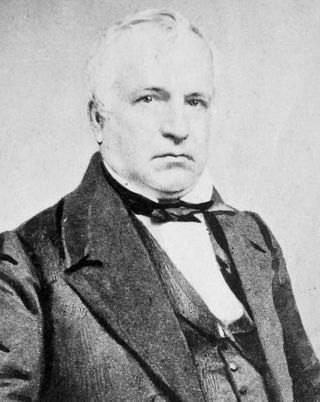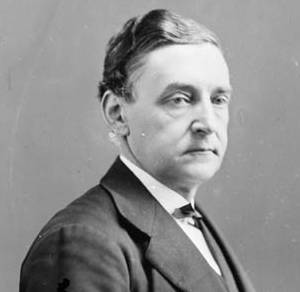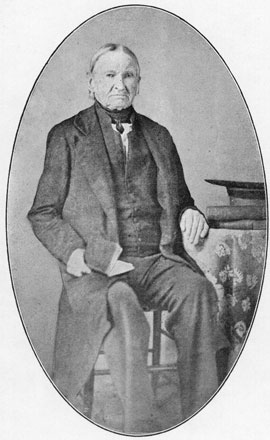
Sir John Alexander Macdonald was the first prime minister of Canada, serving from 1867 to 1873 and from 1878 to 1891. The dominant figure of Canadian Confederation, he had a political career that spanned almost half a century.
The Province of Canada was a British colony in British North America from 1841 to 1867. Its formation reflected recommendations made by John Lambton, 1st Earl of Durham, in the Report on the Affairs of British North America following the Rebellions of 1837–1838.

Robert Baldwin was an Upper Canadian lawyer and politician who with his political partner Louis-Hippolyte Lafontaine of Lower Canada, led the first responsible government ministry in the Province of Canada. "Responsible Government" marked the province's democratic self-government, without a revolution, although not without violence. This achievement also included the introduction of municipal government, the introduction of a modern legal system and the Canadian jury system, and the abolishing of imprisonment for debt. Baldwin is also noted for feuding with the Orange Order and other fraternal societies. The Lafontaine-Baldwin government enacted the Rebellion Losses Bill to compensate Lower Canadians for damages suffered during the Lower Canada Rebellion of 1837–1838. The passage of the Bill outraged Anglo-Canadian Tories in Montreal, resulting in the burning of the Parliament Buildings in Montreal in 1849.

Sir George-Étienne Cartier, 1st Baronet, was a Canadian statesman and Father of Confederation. The English spelling of the name—George, instead of Georges, the usual French spelling—is explained by his having been named in honour of King George III.

Sir Louis-Hippolyte MénardditLa Fontaine, 1st Baronet, KCMG was a Canadian politician who served as the first Premier of the United Province of Canada and the first head of a responsible government in Canada. He was born in Boucherville, Lower Canada in 1807. A jurist and statesman, La Fontaine was first elected to the Legislative Assembly of Lower Canada in 1830. He was a supporter of Papineau and member of the Parti canadien. After the severe consequences of the Rebellions of 1837 against the British authorities, he advocated political reforms within the new Union regime of 1841.

George Brown was a British-Canadian journalist, politician and one of the Fathers of Confederation; attended the Charlottetown and Quebec conferences. A noted Reform politician, he is best known as the founder and editor of the Toronto Globe, Canada's most influential newspaper at the time, and his leadership in the founding of the Liberal Party in 1867. He was an articulate champion of the grievances and anger of Upper Canada (Ontario). He played a major role in securing national unity. His career in active politics faltered after 1865, but he remained a powerful spokesman for the Liberal Party. He promoted westward expansion and opposed the policies of Conservative Prime Minister John A. Macdonald.

The Conservative Party of Canada has gone by a variety of names over the years since Canadian Confederation. Initially known as the "Liberal-Conservative Party", it dropped "Liberal" from its name in 1873, although many of its candidates continued to use this name.

The Liberal-Conservative Party was the formal name of the Conservative Party of Canada until 1873, and again from 1922 to 1938, although some Conservative candidates continued to run under the label as late as the 1911 election and others ran as simple Conservatives before 1873. In many of Canada's early elections, there were both "Liberal-Conservative" and "Conservative" candidates; however, these were simply different labels used by candidates of the same party. Both were part of Sir John A. Macdonald's government and official Conservative and Liberal-Conservative candidates would not, generally, run against each other. It was also common for a candidate to run on one label in one election and the other in a subsequent election.

John Sandfield Macdonald, was the joint premier of the Province of Canada from 1862 to 1864. He was also the first premier of Ontario from 1867 to 1871, one of the four founding provinces created at Confederation in 1867. He served as both premier and attorney general of Ontario from July 16, 1867, to December 20, 1871.

The Blue Party was a political group that contested elections in the Eastern section of the Province of Canada. The Blue Party was ideologically located on the political right, and was defined by its support for the Catholic Church, and later for supporting confederation.
The Red Party was a political group that contested elections in the Eastern section of the Province of Canada. It was formed around 1847 by radical French-Canadians inspired by the ideas of Louis-Joseph Papineau, the Institut canadien de Montréal, and the reformist movement led by the Parti patriote of the 1830s.
The Conservative Party of Quebec was a political party in Quebec, Canada, from 1867 until 1936, when it merged with members of the Action libérale nationale to form the Union Nationale.

Joseph-Édouard Cauchon, was a prominent Quebec politician in the middle years of the nineteenth-century. Although he held a variety of portfolios at the federal, provincial and municipal levels, he never achieved his goal of becoming the Premier of Quebec.

Sir Antoine-Aimé Dorion was a French Canadian politician and jurist.

The Great Coalition was a grand coalition of political parties that brought an end to political deadlock in the Province of Canada. It existed from May 1864 until Confederation in 1867.

Conservatism in Canada is generally considered a movement which is primarily represented by the modern-day Conservative Party of Canada in federal party politics, as well as various centre-right and right-wing parties at the provincial level. The first party which called itself "Conservative" in what would become Canada was elected in the Province of Canada election of 1854.

David Willson (1778–1866) was a religious and political leader who founded the Quaker sect known as, 'The Children of Peace' or 'Davidites,' based at Sharon in York County, Upper Canada in 1812. As the primary minister to this group, he led them in constructing a series of remarkable buildings, the best known of which is the Sharon Temple, now a National Historic Site of Canada. A prolific writer, sympathizer and leader of the movement for political reform in Upper Canada, Willson, together with his followers, ensured the election of William Lyon Mackenzie, and both "fathers of Responsible Government", Robert Baldwin and Louis LaFontaine, in their riding.
Rimouski was an electoral district of the Legislative Assembly of the Parliament of the Province of Canada, in Canada East, in the Lower-Saint Lawrence region. It was created in 1841 and was based on the previous electoral district of the same name for the Legislative Assembly of Lower Canada. It was represented by one member in the Legislative Assembly.
Terrebonne was an electoral district of the Legislative Assembly of the Parliament of the Province of Canada, in Canada East, immediately north-west of Montreal. It was created in 1841, based on the previous electoral district of the same name for the Legislative Assembly of Lower Canada.











